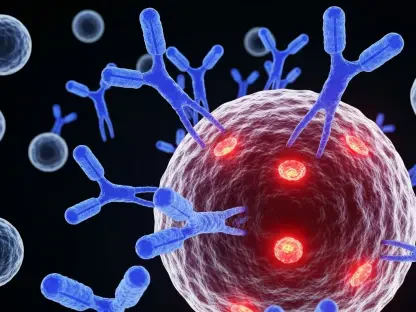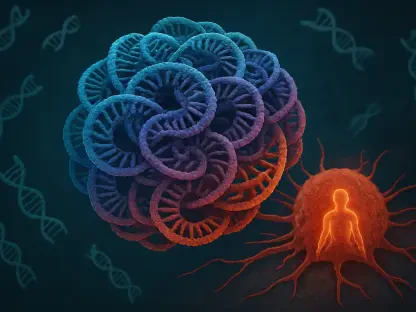A significant breakthrough in the understanding of autism spectrum disorder (ASD) has recently emerged, shedding light on the genetic factors linked to this complex condition and its male predominance. Conducted by researchers from The Hospital for Sick Children (SickKids) in Canada and the Istituto Giannina Gaslini in Italy, the study focuses on the X chromosome’s genetic architecture. This discovery not only provides new insights into ASD’s genetic underpinnings but also opens up potential pathways for more accurate diagnostics and therapeutic interventions. Such advancements are crucial, given the persistent challenge of understanding ASD’s intricate genetic landscape.
Genetic Discovery and ASD
The research identified crucial genetic variants in the DDX53 gene on the X chromosome, establishing their significant contribution to ASD. While the DDX53 gene plays a pivotal role in brain development and function, its connection to autism had previously remained uncharted. This groundbreaking discovery reveals a critical link between the DDX53 gene and the male predominance observed in ASD. By highlighting a specific genetic component tied to brain development, the study sheds light on the biological mechanisms that might contribute to ASD’s prevalence in males.
Further analysis identified another gene, PTCHD1-AS, located near DDX53, also implicated in autism. Researchers presented evidence of a unique gene deletion involving both DDX53 and parts of PTCHD1-AS in a boy and his mother, who were diagnosed with high-functioning autism. This revelation underscores the complexity of autism’s genetic basis and the significant role multiple genetic factors play in the condition’s manifestation. The interplay between these genes illustrates the intricate genetic architecture influencing ASD, providing a broader perspective on the factors contributing to the disorder.
Sex Chromosome Involvement
The study emphasizes the pivotal role sex chromosomes play in ASD, particularly the X chromosome. The researchers suggest a need to re-evaluate current models of studying autism, taking into account the substantial impact sex chromosomes have on the condition. This new perspective calls for more accurate and comprehensive research methodologies, which could reshape our understanding and approach to autism research. Recognizing the influence of sex chromosomes introduces an essential layer to the study of ASD, potentially leading to more nuanced and effective exploration of its genetic roots.
The involvement of the X chromosome offers valuable insights into why autism is more prevalent in males. Since males possess only one X chromosome, any genetic variants on this chromosome can exert a more significant effect compared to females, who have two X chromosomes. This genetic difference may contribute to the higher incidence of ASD in males, further emphasizing the need to consider the unique impact of sex chromosomes. This understanding could lead to tailored approaches in autism research, accounting for inherent genetic differences between genders.
Research Methodology
Employing an extensive and multifaceted approach, the research involved clinical testing of individuals with ASD from diverse families and analysis of large autism research databases, including Autism Speaks MSSNG and Simons Foundation Autism Research Initiative. These comprehensive efforts uncovered additional individuals with rare DDX53 variants, bolstering the gene’s connection to ASD. Combining detailed clinical testing with large-scale database analysis, the study’s methodology highlights the importance of diverse data sources in unraveling autism’s genetic intricacies.
The study showcases advanced genetic analysis techniques, which allowed researchers to identify critical genetic links that had previously been overlooked. By leveraging these sophisticated methods, the researchers demonstrated a thorough and innovative approach to exploring the genetic underpinnings of autism. This robust research methodology serves as a model for future studies, emphasizing a comprehensive approach to investigating complex genetic conditions like ASD. The integration of various data sources and advanced technological tools represents a significant advancement in autism research.
Implications for Future Research
One notable challenge highlighted by the study is the absence of a similar gene like DDX53 in commonly used mouse models, presenting an obstacle for future research. This limitation restricts the ability to study the gene’s function and its role in ASD within a controlled laboratory setting. The necessity for developing new models to better replicate human genetic conditions has been underscored, suggesting a shift in the approach to autism research. This could involve creating more sophisticated animal models or utilizing advanced technologies such as organoids and stem cell-derived neurons to gain deeper insights.
Developing models that more accurately reflect human genetics would enable researchers to explore the biological mechanisms underlying ASD with greater precision. By addressing the current limitations in research models, future studies could provide more comprehensive and relevant findings. This approach would facilitate a better understanding of the intricate genetic factors influencing ASD, driving more effective research efforts. Embracing advanced technologies and innovative models holds promise for significant advancements in the field.
Clinical and Therapeutic Applications
Identifying DDX53 as a contributor to ASD suggests promising advancements for improving clinical genetic testing and developing more precise diagnostics and therapeutics. These findings offer a pathway for better understanding the biological mechanisms underlying ASD, paving the way for tailored interventions. By pinpointing the specific genetic factors involved, researchers can develop targeted therapies that address the unique needs of individuals with autism. Such personalized approaches could significantly enhance the quality of life and long-term outcomes for those affected by the condition.
The study’s findings lay the groundwork for developing therapies that directly target the genetic variants associated with ASD. Focusing on the underlying genetic causes, these therapies offer the potential for more personalized and effective treatment options, addressing the specific needs of individuals with autism. The promise of these targeted therapies extends beyond improving immediate symptoms, aiming for long-term benefits and enhanced quality of life. The study provides a critical step toward realizing these therapeutic advancements.
Collaborative and Funded Research Efforts
A major advancement in understanding autism spectrum disorder (ASD) has been made, shedding light on the genetic factors at play and explaining why it’s more common in males. This research, conducted by teams from The Hospital for Sick Children (SickKids) in Canada and the Istituto Giannina Gaslini in Italy, focused on the genetic makeup of the X chromosome. Their findings offer new insights into the genetic foundations of ASD, presenting important implications for future diagnostics and treatment options. The detailed study of the X chromosome has been particularly revealing, given that it carries many genes potentially linked to autism. Such discoveries are invaluable as they enhance understanding of ASD’s intricate and varied genetic landscape, which has long posed a challenge for scientists and healthcare professionals.
This information is not just academic; it has real-world applications for improving how ASD is diagnosed and managed. As researchers continue to unravel the complexities of genetic contributions to autism, the possibilities for tailored therapeutic strategies grow, offering hope to those affected by ASD and their families. Understanding the genetic mechanisms behind ASD is critical, as it paves the way for precise and effective interventions, ultimately aiming to improve the quality of life for individuals with autism. This breakthrough is a significant step forward in the battle against ASD, providing a foundation for future research and clinical applications.









